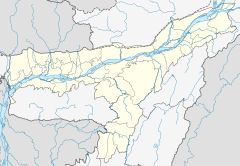| Golakganj railway station | |||||
|---|---|---|---|---|---|
| Indian Railways junction station | |||||
| General information | |||||
| Location | Golakganj, District: Dhubri, Assam India | ||||
| Coordinates | 26°06′30″N 89°49′51″E / 26.1083°N 89.8307°E / 26.1083; 89.8307 | ||||
| Elevation | 31 metres (102 ft) | ||||
| Owned by | Indian Railways | ||||
| Operated by | Northeast Frontier Railway | ||||
| Line(s) | Fakiragram–Dhubri branch line New Cooch Behar–Golakganj branch line. | ||||
| Platforms | 2 | ||||
| Tracks | 3 | ||||
| Construction | |||||
| Structure type | Standard on ground | ||||
| Parking | yes | ||||
| Bicycle facilities | Yes | ||||
| Other information | |||||
| Status | Functioning | ||||
| Station code | GKJ | ||||
| Zone(s) | Northeast Frontier Railway | ||||
| Division(s) | Alipurduar | ||||
| History | |||||
| Opened | 1900–1910? | ||||
| Previous names | Eastern Bengal Railway | ||||
| |||||
Golakganj is a railway junction station on the Fakiragram–Dhubri branch line and the New Cooch Behar–Golakganj branch line. A new line is being laid to connect Golakganj with Jogighopa. It is located in Dhubri district in the Indian state of Assam. This station serves the Golakganj town. Important trains like Alipurduar–Silghat Town Rajya Rani Express, Siliguri–Dhubri Intercity Express are available from this station.
Geography
5milesASS A MWES T BENGALBAN G LADESH Brahmaputra
River Gangadhar River River Dudhkumar Dharla River GolokganjRS Sonahat
Land PortR
CT: census town, R: rural/ urban centre, RS: railway station
Owing to space constraints in the small map, the actual locations in a larger map may vary slightly
Dhubri district occupies the south-west corner of Assam. It borders on Bangladesh, and the Indian states of West Bengal and Meghalaya. The Brahmaputra divides the district into two parts. Tributaries of the Brahmaputra such as Gangadhar, Gaurang, Tipkai, Champamoti in the north and Jinjiram, Jinari and Kaloo in the south are all major contributors of floods in the area.
History
In pre-independence days (in the early 1900s), there was a 1,000 mm (3 ft 3+3⁄8 in)-wide metre-gauge line: Katihar–Radhikapur–Biral–Parbatipur–Tista–Gitaldaha–Golakganj–Fakiragram.
With the partition of India in 1947, railways in Assam got delinked from that of the rest of India. Indian Railway took up the Assam Link Project in 1948 to build a metre-gauge rail link between Fakiragram and Kishanganj. Fakiragram was connected to the Indian railway system in 1950.
In the mid 1960s, the first 5 ft 6 in (1,676 mm) broad gauge line was laid in the area from New Jalpaiguri to Jogihopa via New Bongaigaon.
The Fakiragram–Dhubri line was opened in September 2010 after conversion to broad gauge.
Up to the sixties there was a railway link from Cooch Behar to Dhubri via Golokganj. It was then known as the Assam Line Railway Service. It also connected East Pakistan, even after partition. However, collapse of the rail-cum-road bridge over the Gadadhar in the seventies ended that link. The bridge has been rebuilt and the track laid again as broad gauge, entirely through Indian territory. The line became operable in 2012. Dhubri–New Jalpaiguri Inter-city Express via New Cooch Behar was introduced in February 2012.
Note: The map alongside presents the position as it stands today (2020). The international border was not there when the railways were first laid in the area in the 19th–20th century. It came up in 1947. Since then, it has been an effort to live up to the new realities. The map is 'Interactive' (the larger version) – it means that all the places shown in the map are linked in the full screen map.
References
- "05418/Silghat Town - Alipurduar Rajya Rani Special". indiarailinfo.com.
- "Siliguri-Dhubri Intercity Express". indiarailinfo.com.
- "Dhubri district at a glance". Dhubri district administration. Archived from the original on 12 May 2013. Retrieved 10 May 2013.
- "District Disaster Management Plan of Dhubri" (PDF). Dhubri district administration. Retrieved 10 May 2013.
- "Geography – International". IRFCA. Retrieved 10 December 2011.
- "India: the complex history of the junctions at Siliguri and New Jalpaiguri". IRFCA. Retrieved 12 November 2011.
- "Some Milestones of NF Railway". Archived from the original on 24 November 2011. Retrieved 28 January 2012.
- "Gauge conversion project in Assam". The Hindu Business Line. 24 May 2000. Archived from the original on 3 January 2013. Retrieved 10 December 2011.
- "Mamata flags off two trains- Dhubri–Kamakhya link after 22-year wait". The Telegraph. 14 September 2010. Archived from the original on 26 April 2012. Retrieved 10 December 2011.
- "Dhubri–Bengal Link Soon". The Telegraph. 29 December 2011. Archived from the original on 13 September 2012. Retrieved 2 February 2012.
- "Two new trains flagged off". The Telegraph. 12 February 2012. Archived from the original on 30 June 2013. Retrieved 10 May 2012.
External links
- Golokganj railway station at the India Rail Info
| Preceding station | Following station | |||
|---|---|---|---|---|
| Moterjhartowards ? | Northeast Frontier Railway zoneFakiragram–Dhubri branch line | Gauripurtowards ? | ||
| Terminus | Northeast Frontier Railway zoneNew Cooch Behar–Golokganj branch line | Agomonitowards ? | ||
| Railway stations in Assam | |||||||||
|---|---|---|---|---|---|---|---|---|---|
| NEFRTooltip Northeast Frontier Railway zone |
| ||||||||

